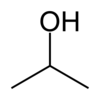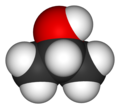異丙醇
| A+醫學百科 >> 異丙醇 |
英文品名: iso-Propyl alcohol ;isopropanol;Dimethylcarbinol;2-Propanol俗稱IPA
分子式: C3H8O;(CH3)2CHOH
它是正丙醇 CH3-CH2-CH2OH 的同分異構體。
InChI 1/CH4N2O/c2-1(3)4/h(H4,2,3,4)/f/h2-3H2
CAS號67-63-0
RTECS號 NT8050000
目錄 |
理化特性
分子量:60.07 g/mol
密度 SpecificGravity: 0.78505(Water=1)
性狀:無色透明揮發性液體。有似乙醇和丙酮混合物的氣味,其氣味不大。其蒸汽能對眼睛、鼻子和咽喉產生輕微刺激;能通過皮膚被人體吸收。
能與水、醇、醚相混溶。
與水能形成共沸物。
它易燃,蒸氣與空氣形成爆炸性混合物,爆炸極限lower 2.5 vol.% Upper 12.7 vol.%(體積)屬於一種中等爆炸危險物品。
其蒸汽能滾動流過相當長的距離,並能產生回火。
蒸氣壓(Pa):92232(80℃);38463(60℃);1187(0℃)
粘度 2.86 cP at 15 °C ;1.77 cP at 30 °C
粘度 mPa•s(20℃):2.1
沸點BoilingPoint: 82.5°C(180.5°F)
熔點MeltingPoint: -88.5°C(-127.3°F)
臨界點CriticalTemperature: 235°C(455°F)
自燃點:425℃
閃點12℃(閉杯)
蒸氣密度VaporDensity: 2.07(空氣Air=1)
蒸氣壓VaporPressure: 4.4kPa(@20°C)
分子偶極距 1.66 D 氣態
毒性:有毒。
折射率:1.3776
Odor:Pleasant.Odorresemblingthatofamixtureof
ethanolandacetone.
Taste: Bitter.(Slight.)
pH(1%soln/water): Notavailable.
Volatility: Notavailable.
OdorThreshold:22ppm(Sittig,1991)700ppmforunadaptedpanelists(Verschuren,1983).
Water/OilDist.Coeff.: Theproductisequallysolubleinoilandwater;log(oil/water)=0.1
Ionicity(inWater): Notavailable.
DispersionProperties: Seesolubilityinwater,methanol,diethylether,n-octanol,acetone.
mp -88.5℃.bp82.5℃.Fp(閉杯)53℃(.7℉)n20D1.3772。
毒性LD50(mg/kg):大鼠經口5800。
主要用途
重要的化工產品和原料。主要用於製藥、化妝品、塑料、香料、塗料及電子工業上用作脫水劑及清洗劑。測定鋇、鈣、鎂、鎳、鉀、鈉和鍶等的試劑。色譜分析參比物質。電子工業用。在許多工業和消費產品中,異丙醇用作低成本溶劑,也用作萃取劑。歐洲溶劑工業集團(ESIG)稱,2001年歐洲中間體需求佔到異丙醇消費量的32%,有14%的異丙醇用作防冰劑,13%用於油漆和樹脂,9%用於藥物,4%用於食品和3%用於油墨和粘合劑。異丙醇還用作油品和膠體的溶劑,以及用於魚粉飼料濃縮物的製造中。低品質的異丙醇用在汽車燃料中。 異丙醇作為丙酮生產原料的用量在下降。有幾種化合物是用異丙醇合成的,如甲基異丁基酮和許多酯。可根據最終用途供應不同品質的異丙醇。無水異丙醇的常規質量為99%以上,而專用級異丙醇含量在99.8%以上(用於香精和藥物)。用於製取丙酮、二異丙醚、乙酸異丙酯和麝香草酚等。在許多情況下可代替乙醇使用。
製備方法
先用 90 ~ 95% 硫酸吸收丙烯 CH3CHCH2( 從熱裂石油氣分出 ) ,繼加水分解異丙基硫酸,再用蒸餾法蒸出異丙醇。或用酸性陽離子樹脂和矽鎢酸均相催化劑使丙烯水合而得。
包裝儲運
一級易燃液體。密封保存。150Kg桶包裝,應處於陰涼、通風的專用倉庫內,遠離火源,按易燃化學品規定儲運。
材料安全數據表】(中英雙語)
MSDS異丙醇
第一部分:化學品名稱
化學品中文名稱: 2-丙醇
化學品英文名稱: 2-propanol
中文名稱2: 異丙醇
英文名稱2: isopropyl alcohol
技術說明書編碼: 149
CAS No.: 67-63-0
分子式: C3H8O
分子量: 60.10
第二部分:成分/組成信息
有害物成分 含量 CAS No.
2-丙醇 67-63-0
第三部分:危險性概述
危險性類別:
侵入途徑:
健康危害: 接觸高濃度蒸氣出現頭痛、倦睡、共濟失調以及眼、鼻、喉刺激症状。口服可致噁心、嘔吐、腹痛、腹瀉、倦睡、昏迷甚至死亡。長期皮膚接觸可致皮膚乾燥、皸裂。
環境危害:
燃爆危險: 本品易燃,具刺激性。
第四部分:急救措施
皮膚接觸: 脫去污染的衣著,用肥皂水和清水徹底沖洗皮膚。
眼睛接觸: 提起眼瞼,用流動清水或生理鹽水沖洗。就醫。
吸入: 迅速脫離現場至空氣新鮮處。保持呼吸道通暢。如呼吸困難,給輸氧。如呼吸停止,立即進行人工呼吸。就醫。
食入: 飲足量溫水,催吐。洗胃。就醫。
第五部分:消防措施
危險特性: 易燃,其蒸氣與空氣可形成爆炸性混合物,遇明火、高熱能引起燃燒爆炸。與氧化劑接觸猛烈反應。在火場中,受熱的容器有爆炸危險。其蒸氣比空氣重,能在較低處擴散到相當遠的地方,遇火源會著火回燃。
滅火方法: 儘可能將容器從火場移至空曠處。噴水保持火場容器冷卻,直至滅火結束。處在火場中的容器若已變色或從安全泄壓裝置中產生聲音,必須馬上撤離。滅火劑:抗溶性泡沫、乾粉、二氧化碳、砂土。
第六部分:泄漏應急處理
應急處理: 迅速撤離泄漏污染區人員至安全區,並進行隔離,嚴格限制出入。切斷火源。建議應急處理人員戴自給正壓式呼吸器,穿防靜電工作服。儘可能切斷泄漏源。防止流入下水道、排洪溝等限制性空間。小量泄漏:用砂土或其它不燃材料吸附或吸收。也可以用大量水沖洗,洗水稀釋後放入廢水系統。大量泄漏:構築圍堤或挖坑收容。用泡沫覆蓋,降低蒸氣災害。用防爆泵轉移至槽車或專用收集器內,回收或運至廢物處理場所處置。
第七部分:操作處置與儲存
操作注意事項: 密閉操作,全面通風。操作人員必須經過專門培訓,嚴格遵守操作規程。建議操作人員佩戴過濾式防毒面具(半面罩),戴安全防護眼鏡,穿防靜電工作服,戴乳膠手套。遠離火種、熱源,工作場所嚴禁吸煙。使用防爆型的通風系統和設備。防止蒸氣泄漏到工作場所空氣中。避免與氧化劑、酸類、鹵素接觸。灌裝時應控制流速,且有接地裝置,防止靜電積聚。搬運時要輕裝輕卸,防止包裝及容器損壞。配備相應品種和數量的消防器材及泄漏應急處理設備。倒空的容器可能殘留有害物。
儲存注意事項: 儲存於陰涼、通風的庫房。遠離火種、熱源。庫溫不宜超過30℃。保持容器密封。應與氧化劑、酸類、鹵素等分開存放,切忌混儲。採用防爆型照明、通風設施。禁止使用易產生火花的機械設備和工具。儲區應備有泄漏應急處理設備和合適的收容材料。
第八部分:接觸控制/個體防護
職業接觸限值
中國MAC(mg/m3): 200
前蘇聯MAC(mg/m3): 10
TLVTN: OSHA 400ppm,985mg/m3; ACGIH 400ppm,983mg/m3
TLVWN: ACGIH 500ppm,1230mg/m3
監測方法:
工程式控制制: 生產過程密閉,全面通風。提供安全淋浴和洗眼設備。
呼吸系統防護: 一般不需要特殊防護,高濃度接觸時可佩戴過濾式防毒面具(半面罩)。
眼睛防護: 一般不需要特殊防護,高濃度接觸時可戴安全防護眼鏡。
身體防護: 穿防靜電工作服。
手防護: 戴乳膠手套。
其他防護: 工作現場嚴禁吸煙。保持良好的衛生習慣。
第九部分:理化特性
主要成分: 純品
外觀與性狀: 無色透明液體,有似乙醇和丙酮混合物的氣味。
pH:
熔點(℃): -88.5
沸點(℃): 80.3
相對密度(水=1): 0.79
相對蒸氣密度(空氣=1): 2.07
飽和蒸氣壓(kPa): 4.40(20℃)
燃燒熱(kJ/mol): 1984.7
臨界溫度(℃): 275.2
臨界壓力(MPa): 4.76
辛醇/水分配係數的對數值: <0.28
閃點(℃): 12
引燃溫度(℃): 399
爆炸上限%(V/V): 12.7
爆炸下限%(V/V): 2.0
溶解性: 溶於水、醇、醚、苯、氯仿等多數有機溶劑。
主要用途: 是重要的化工產品和原料。主要用於製藥、化妝品、塑料、香料、塗料等。
其它理化性質:
第十部分:穩定性和反應活性
穩定性:
禁配物: 強氧化劑、酸類、酸酐、鹵素。
避免接觸的條件:
聚合危害:
分解產物:
第十一部分:毒理學資料
急性毒性: LD50:5045 mg/kg(大鼠經口);12800 mg/kg(兔經皮)
LC50:無資料
亞急性和慢性毒性:
刺激性:
致敏性:
致突變性:
致畸性:
致癌性:
第十二部分:生態學資料
生態毒理毒性:
生物降解性:
非生物降解性:
生物富集或生物積累性:
其它有害作用: 該物質對環境可能有危害,對水體應給予特別注意。
第十三部分:廢棄處置
廢棄物性質:
廢棄處置方法: 用焚燒法處置。
廢棄注意事項:
第十四部分:運輸信息
危險貨物編號: 32064
UN編號: 1219
包裝標誌:
包裝類別: O52
包裝方法: 小開口鋼桶;安瓿瓶外普通木箱;螺紋口玻璃瓶、鐵蓋壓口玻璃瓶、塑料瓶或金屬桶(罐)外普通木箱;螺紋口玻璃瓶、塑料瓶或鍍錫薄鋼板桶(罐)外滿底板花格箱、纖維板箱或膠合板箱。
運輸注意事項: 運輸時運輸車輛應配備相應品種和數量的消防器材及泄漏應急處理設備。夏季最好早晚運輸。運輸時所用的槽(罐)車應有接地鏈,槽內可設孔隔板以減少震蕩產生靜電。嚴禁與氧化劑、酸類、鹵素、食用化學品等混裝混運。運輸途中應防曝晒、雨淋,防高溫。中途停留時應遠離火種、熱源、高溫區。裝運該物品的車輛排氣管必須配備阻火裝置,禁止使用易產生火花的機械設備和工具裝卸。公路運輸時要按規定路線行駛,勿在居民區和人口稠密區停留。鐵路運輸時要禁止溜放。嚴禁用木船、水泥船散裝運輸。
第十五部分:法規信息
MSDS簡要說明了一種化學品對人類健康和環境的危害性並提供如何安全搬運、貯存和使用該化學品的信息。作為提供給用戶的一項服務,生產企業應隨化學商品向用戶提供安全說明書,使用戶明了化學品的有關危害,使用時能主動進行防護,起到減少職業危害和預防化學事故的作用.MSDS可由生產廠家按照相關規則自行編寫.MSDS評估認證報告是應產品進口國的法律規定與要求編寫的。目前化學品評估編寫的法律規定,國際上尚沒有統一的標準,一般國際通行的版本是歐盟的EEC/ISO版本,和美國的OSHA及ANSI版本。由於各個國家,甚至各個州的化學品管理及貿易的法律文件不一樣,有的每個月都有變動,如果提供的MSDS報告不正確或者信息不完全,將面臨法律責任追究。所以目前國外的客戶一般都要求其材料供應商,提供經專業的第三方檢測機構進行的MSDS材料安全評估認證譜尼報告,防止由於材料供應商自己編寫的MSDS報告不符合相關國家的法律規定,或者MSDS報告提供的材料安全數據不符實所造成的安全事故及法律責任。
法規信息 化學危險物品安全管理條例 (1987年2月17日國務院發布),化學危險物品安全管理條例實施細則 (化勞發[1992] 677號),工作場所安全使用化學品規定 ([1996]勞部發423號)等法規,針對化學危險品的安全使用、生產、儲存、運輸、裝卸等方面均作了相應規定;常用危險化學品的分類及標誌 (GB 13690-92)將該物質劃為第3.2 類中閃點易燃液體。
【MSDS】
HAZARDS IDENTIFICATION
Product Name
PROPAN-2-OL
Proper Shipping Name
ISOPROPANOL (ISOPROPYL ALCOHOL)
Other Names
Name
Grade
Labscan Code:PROPAN-2-OL
AR:A3515
PROPAN-2-OL
HPLC
C2519
PROPAN-2-OL
PESTI
P5515
PROPAN-2-OL
SPECTRO
S7515
ISO-PROPYL ALCOHOL
ISOPROPANOL
2-PROPANOL
SEC-PROPYL ALCOHOL
UN No.:1219
D.G. Class:3.2
Packing Group:II
Hazchem Code:2[Y]E
Poisons schedule:Not schedule
EEC-No: 603-003-00-0
Class: F; R11; Xo R36; R67
CAS-No:67-63-0
Weight
100%
Most Important hazards
Highly flammable, Irritant effect on eyes.
Specific hazards
Liquid causes severe inflammation of conjunctiva and may cause severe damage of the
cornea. Repeated or prolonged exposure may cause skin irritation and dermatitis, due to
degreasing properties of the product. Effects due to ingestion may include: vomiting,
dizziness, abdominal pain & unconsciousness. Effects of breathing high concentrations of
vapor may include; headache, irritation of respiratory system, nausea, vomiting, dizziness &
unconsciousness.
FIRST AID
General advice:
Show this safety data sheet to the doctor in attendance.
Inhalation:
Move to fresh air in case of accidental inhalation of vapors. Keep patient warm. In case of
shortness of breath, give oxygen. Apply artificial respiration only if patient is not breathing or
under medical supervision.
No artificial aspiration mouth-to-mouth or mouth to nose. Use
suitable instruments / apparatus.
Skin contact:
Remove contaminated clothing and wash affected skin with soap and water. If signs of poisoning
appear, treat as for inhalation. Wash contaminated clothing before re-use. Contaminated
combustible material, e.g. clothing ignites more readily and burns fiercely.
Eye contact:
If the substance has got into the eyes, immediately wash out with plenty of water or saline solution
for at least 15 minutes. Obtain medical attention.
Ingestion:
Clean mouth with water and drink afterwards plenty of water. Do not induce vomiting. Keep
patient warm. In case of shortness of breath, give oxygen. Apply artificial respiration only if
patient is not breathing or under medical supervision. No artificial aspiration mouth-to-mouth to
nose. Use suitable instruments / apparatus. Obtain medical attention.
FIRE-FIGHTING MEASURES
Suitable extinguishing media:
Extinguish preferably with dry chemical / alcohol-resistant foam sand.
Extinguishing media which must not be used for safety reasons:
Do not use water jet.
Specific hazards:
Carbon oxides.
Special protective equipment for firefighters:
Wear self-contained breathing apparatus and protective suit.
Specific methods:
Standard procedure for chemical fires. Water mist may be used to cool closed containers.
Hazchem Code:
2 [Y] E
ACCIDENTAL RELEASE MEASURES
Personal precautions:
Evacuate personnel to safe areas. Remove all sources of ignition. Wear self-
contained breathing apparatus and protective suit. Shut off leaks if without risk.
Keep people away from and upwind of spill/leak.
Environmental precautions:
Contain or absorb leaking liquid with sand or earth. Prevent liquid entering
sewers basements and work pits; If substance has entered a water course or
sewer or contaminated soil or vegetation, advise police.
Methods for cleaning up:
Soak up with inert absorbent material (e.g. sand, silica gel, acid binder,
universal binder, sawdust). Transfer to covered steel drums. Contact waste
disposal services. Dispose of promptly.
SAFE HANDLING AND STORAGE INFORMATION
Handling:
Use only in well-ventilated areas. Do not breathe vapors or spray mist. Avoid contact with
skin, eyes and clothing. Take necessary action to avoid static electricity discharge (which
might cause ignition of organic vapors.)
Storage:
Keep tightly closed in a dry, cool and well-ventilated place.
Keep away from heat and sources of ignition. Store in original container.
Electrical equipment should be protected to the appropriate standard.
EXPOSURE CONTROLS / PERSONAL PROTECTION
Chemical Name:
National occupational exposure limits:
ISOPROPYL ALCOHOL
EH40:OES 400 ppm (980 mg/m3) 8h TWA.
EH40:OES 500 PPM (1225 MG/M3)15 min TWA.
Engineering measures to reduce exposure:
The product should only be used in areas from which all naked lights and other sources of ignition have been
excluded. Ventilation hoods and fans required when working with organic solvents or in hot melt applications.
Personal protection equipment:
Respiratory protection:
Incase of insufficient ventilation, wear suitable respiratory equipment.
Hand protection:
PVC or other plastic material gloves.
Eye protection:
Goggles giving complete protection to eyes.
Skin and body protection:
Rubber or plastic boots, Chemical resistant apron / complete suit protecting
against chemicals.
Hygiene measures:
Keep working clothes separately. Keep away from food, drink and animal feeding stuffs.
PHYSICAL DATA AND OTHER PROPERTIES
Formula
(CH3)2CHOH
Form Liquid,
Colour Colourless,
Odour Alcoholic
Boiling point/range
79-82oC
Melting point/range
–88oC
Flash point
12 open cup oC
Autoignition temperature
> 400oC
Flammability limits high flammable
Explosion limits lower 2.5 vol.% Upper 12.7 vol.%
Vapour pressure(20oC)41.6hPa
Relative density(20oC)>= 0.785 <= 0.825
Bulk density 786 kg/m3
Solubility
Water solubility
completely miscible
g/l
Solubility in other solvents
Alcohol & Ether
Viscosity
(20oC)
3.057 (cST)
mPa.s
STABILITY AND REACTIVITY
Stability:
Stable at normal conditions.
No incompatible products to be specially mentioned.
Conditions to avoid:
Stable at normal conditions.
Materials to avoid:
Strong oxidizing agents.
Hazardous decomposition products:
None reasonably for seeable.
TOXICOLOGICAL INFORMATION
Acute toxicity:
Ingestion:
LD50/oral/rat = 5840 mg/kg.
Inhalation:
LD50/inhalation/4h/rat = 46.5 mg/l.
Skin contact:
LD50/dermal/rabbit => 12800 mg/kg.
Sensitization:
Irritant effect on eyes.
Irritant to skin.
Irritating to respiratory system.
Long term toxicity:
Repeated and prolonged exposure may cause skin irritation and dermatitis, due to
degreasing properties of the product.
Chronic toxicity:
No data is available on the product itself.
ECOLOGICAL INFORMATION
Mobility:
Completely miscible with water.
Persistence / degradability:
Readily biodegradable, according to appropriate OECD test
Biochemical oxygen demand (BOD) =>78% theoretical oxygen demand (ThOD)(BOD20)
Bio accumulation:
Bio accumulation not applicable. Bio concentration factor (BCF) = 1
Ecotoxicity:
LC50/96h/fathead minnows = 9600 mg/l.
LC50/24h/daphnia
= > 1000 mg/l.
DISPOSAL CONSIDERATIONS
Waste from residues / unused products:
Can be incinerated, when in compliance with local regulations.
Contact waste disposal services.
Contaminated packaging:
Empty containers can be land filled after cleaning, when in compliance with local regulations.
Continued on next page
PRODUCT NAME : ISO PROPYL ALCOHOL
TRANSPORT INFORMATION
UN-No…………………..…...1219
Marine pollutant…..………not applicable
ADR/RID
Class…………………..……..3.0
Item………………………….3(b)
TREM-CARD………….……..LAB30TR30
HI/UN No……………………33/1219
Proper shipping name…….ISOPROPANOL (Isopropyl alcohol)
IMO
Class………………..………..3.2
EmS…………………………3-06
MFAG………………………...305
IMDG Page…………………3244
Proper shipping name…….ISOPROPANOL (Isopropyl alcohol)
Packaging group………….II
ICAO
Class……………………..…..3.0
UN/ID No……………………1219
Proper shipping name…….ISOPROPANOL (Isopropyl alcohol)
REGULATORY INFORMATION
Classification according to European directive on classification of hazardous preparations 90/492/EEC
Contains:
ISO PROPYL ALCOHOL
Symbol(s):
F – Highly flammable
R – phrase(s)
R11
– Highly flammable.
R36
- Irritating to eyes.
R67
- Vapours may cause drowsiness and dizziness.
S – phrase(s)
S7
- Keep container tightly closed.
S16
- Keep away from sources of ignition – No smoking.
S24/25
- Avoid contact with skin and eyes.
S26
- In case of contact with eyes, rinse immediately with plenty of water and seek
medical advice.
Recommended restrictions:
Take notice of labels and material safety data sheets for the working chemicals.
Take necessary action to avoid static electricity discharge (which might cause
ignition of organic vapors.)
Recommended use:
General purpose solvent.
End of MSDS
|
||||||||||||||||||||||||||||||||
| 關於「異丙醇」的留言: | |
|
目前暫無留言 | |
| 添加留言 | |

